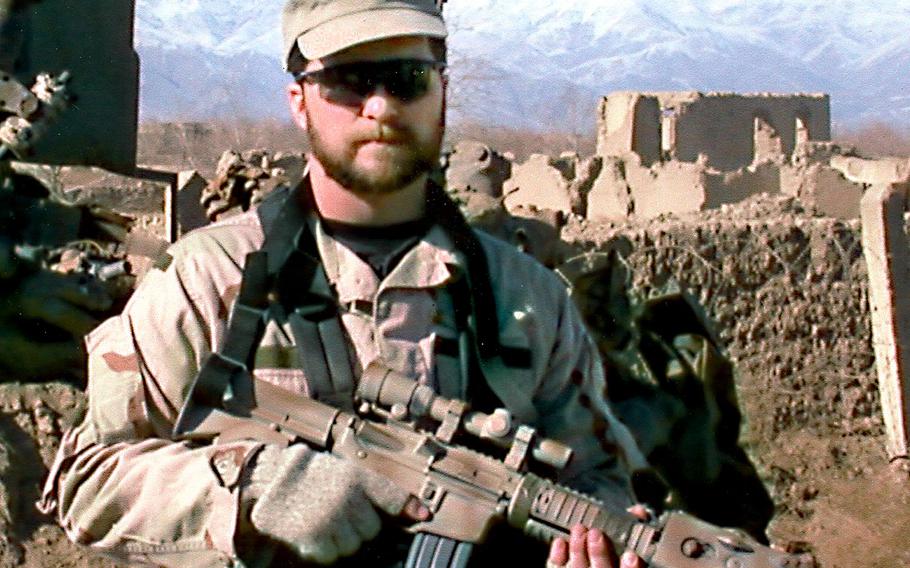
Air Force Tech. Sgt. John A. Chapman, a combat controller, was killed during a fierce battle against al Qaida fighters in Takur Ghar, Afghanistan, March 4, 2002. He was posthumously awarded the Medal of Honor and promoted to master sergeant. (U.S. Air Force)
WASHINGTON — The life-sized statue of Master Sgt. John Chapman, the Air Force’s lone post-9/11 recipient of the Medal of Honor, will be the image that students and cadre see as they enter or leave the service’s school for future combat controllers.
The statue of the bearded, combat-outfitted Chapman set to be unveiled Thursday morning at the service’s Combat Control School was modeled on photos from his days in Afghanistan before he was killed in action on March 4, 2002 atop a snow-capped mountain, where he held off scores of al-Qaida terrorists so other American troops could escape the two-day firefight, which would come to be known as the Battle of Roberts Ridge. Air Force officials hope the statue will inspire generations of the service’s elite ground fighters, responsible for directing air and artillery strikes from battlefields where they work alongside elite special operators such as Navy SEALs and Army Green Berets and Rangers.
“When students come in and out every day this is what they will see, and it reminds students, that, ‘Hey, you might have to make this sacrifice.’ It’s perfectly placed within the squadron,” said Air Force Maj. Michael Bain, the commander of the 352nd Special Warfare Training Squadron, which trains combat control students and special operations officers. “It’s a piece of pride … to know that those that came before you in the same squadron did the same things that you are doing, which are still occurring, and they are part of that family.”
The Chapman statue will sit at the entrance into the 352nd’s headquarters building on Pope Army Airfield at Fort Bragg in North Carolina alongside a display of the Medal of Honor that Chapman’s family was presented in August, an upgrade of the Air Force Cross that he was initially awarded after dying in combat. The dedication on Thursday will feature top Air Force officials, including the service’s vice chief, Gen. Stephen Wilson. Chapman’s family, including his widow Valerie Nessel, intend to attend.
“It is particularly impactful that John’s legacy is standing guard over the future of our combat control community — a community I consider to be family.” Nessel said in a statement. “I hope John’s dedication and sacrifice continue to inspire the next generation of heroes who are answering the call to serve and protect our nation. And that they always remember the stories of those who have gone before them, so their names are never forgotten.”
The upgrade of Chapman’s Air Force Cross last summer to the Medal of Honor was the result of a yearslong, painstaking review of his actions atop Takur Gar mountain between March 3 and 4, 2002. Air Force officials last year detailed the massive review, which included combat footage taken from American drones and interviews with servicemembers who fought with Chapman on the ground and from the air.
That probe revealed Chapman — unconscious and believed dead by his fellow troops — had been left alone on the mountain after a helicopter crashed and the mission had gone awry. However, Chapman later regained consciousness and fought off enemy attackers for an hour before a helicopter carrying an assault force of Army Rangers approached. He then, from the protection of a chest-high, World War II-style pillbox bunker, took it upon himself to charge forward, turning his back on an enemy machine gun and fired on two fighters preparing to launch rocket-propelled grenades at the incoming helicopter, which military officials credited with saving the lives of those Army Rangers and others.
Chapman, whose death was the result of nearly a dozen gunshot wounds, according to the Air Force, was among seven Americans killed in the battle. He was the second servicemember to receive the Medal of Honor for actions during that battle.
A technical sergeant at the time of his death, Chapman was posthumously promoted to master sergeant.
Bain, who was a senior airman at the time of Chapman’s death, said he looked up to the 36-year-old, 17-year Air Force veteran as a friend and a mentor.
They first met in 1997 and spent several years working together in the 24th Special Tactics Squadron, the Air Force’s most elite commando team. The two shared an interest in classic cars and in bettering themselves as combat controllers.
“Everything was easy to him,” Bain said Wednesday in an interview. “The No. 1 attribute you look for [in] people within the [special operations forces] community is humility. The man humbled himself every day. He would say he works very hard to be mediocre. He wasn’t mediocre. He excelled at everything.”
Chapman was the first friend Bain would lose in combat.
“I’m just glad [Chapman] will be here again,” the major said of the new statue. “He was unique. It’s kind of weird to have the brawn and the brains, you know. And he did. I wanted to be him.”
Twitter: @CDicksteinDC